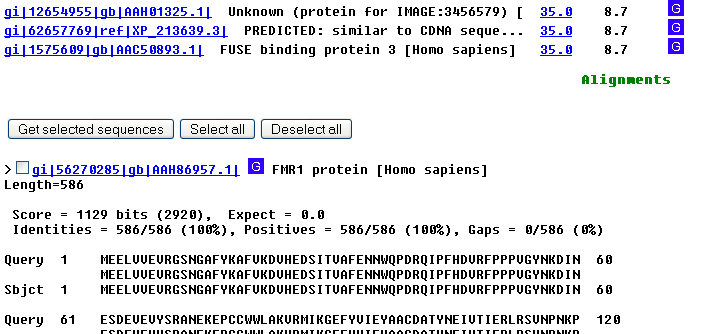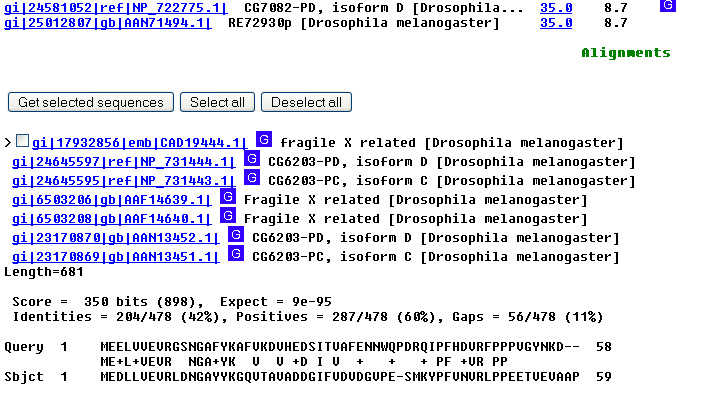Search for FMRP in Drosophila
Our strategy is to get the sequence of the human FMRP
protein and then use it to scan the Drosophila genome to find the
gene we want.
-
From the course
web site, click on Resources and Links and then on NCBI (National
Center for Biotechnology Information, a repository of vast amounts of information).
-
Click on the down arrow to expand the choices for the Search
box from All Databases, and select Protein.

-
Enter FMRP into the for box, and press Go (or
press Enter).
-
You might expect to pull up an entry for the human FMRP gene,
but no such luck. The search returned 181 entries (!), some from flies,
some from mice... (This number may be different depending on when you're
doing this search). Let's try to reduce the number to something more managable.
-
Click on Preview/Index. At the bottom of the resulting screen,
you'll see a mechanism to add terms. Click on the down arrow to expand
the choices from All fields and select Organism, then type
human
into the box to the right. Finally, click AND (to specify that you're looking
for entries that contain the word FMRP AND the organism human),
and click Go.
-
I got 30 entries now. Certainly an improvement, but surely
humans don't have 30 different FMRP proteins! The problem is that we're
searching multiple overlapping databases and getting the same protein back
multiple times. To cure that, click on Limits, expand the choices
in the right-most box from Only from, and select a single database
(I chose GenBank). Press Go again.
-
Now we're down to 4 entries. They're different from each
other in ways that need not concern us now. Click on the entry with the
accession number AAH86957.
-
Lots of information here. One important item is a reference
to a journal article that describes the work that led to the results you're
looking at. Clicking on the PubMed number leads you to an abstract and
a link to the full length article. But what we're after right now is the
protein sequence, seen at the bottom of the page. The sequence is given
according to the one-letter amino acid codes (see course
web site, Links and Resources, Genetic Code, for a list of them).
-
The display is good for some purposes -- the numbering makes
it easy for humans to find what amino acid is at a specific positions --
but computers prefer straight sequence, without numbers or spaces. To get
this, scroll back up to the top of the page, click on the down arrow to
expand the Display box from GenPept, and select FastA. I could explain
what FastA format is, but if you've gotten this far, you're now looking
at it: One line of documentation preceded by ">" and multiple lines of
sequence. If you want to save this file, click on the down arrow to expand
the box showing Send to, and select Text. Then use the browser
to save the file. Alternatively, just copy the sequence, with or without
the documentation line.
-
Now we're ready to do the search. Click on NCBI at the top
of the screen to return to NCBI home page, and click on Blast in
the horizontal toolbar near the top of the page. Blast (Basic Local Alignment
Search Tool) is undoubtedly the most widely used bioinformatic tool in
existence. We'll talk about what it does and how it does it, but for now,
let's use it to find the fruit-fly gene we want. We have a protein sequence,
and we want to find a fruit-fly protein, so look in the Protein
box and click on Protein-protein BLAST.
-
Paste the FMRP sequence into the Search box and click
on Blast. You'll probably get the formatting BLAST page up
pretty quickly, showing conserved domains in the protein. That's for another
day. For now, click on Format to get the search results. These results
may take tens of seconds to come up.
-
Again, way too many hits! We'll cut them down in a moment,
but first,, scroll down until you see things like:

This shows the alignment of the protein we submitted (human
FMR1 protein), the Query, to the protein Blast found, the Subject. The
best hit happens to be human FMR1 protein. No surprise! It found itself!
Continue to scroll down and you'll see similar proteins from other organisms:
dog (Canis familiaris), cow (Bos taurus), orangutan (Pongo
pygmaeus), mouse, rat, chimp... the amazing thing is that this protein
is nearly identical amongst mammals. The same is true of most protein.
We share a common toolbox.
-
Kill the screen, returning to the formatting window. Scrolling
down, you'll see that you have the option of selecting which organism you
want to focus on. Click on the down arrow in the select from window,
expanding the selection from All organisms, and select Drosophila
melanogaster[ORGN]. Then click Format again.
-
Much better! Now you have only a few hits, all from Drosophila.
Here's the top hit:

There are 7 entries that have the identical sequence, from three different
databases (emb=European Molecular Biology Laboratory; ref=RefSeq; and gb=GenBank).
You'll notice that the degree of similarity between the human and fly FMRP
protein is much less than between human and mammalian proteins. Only 42%
of the amino acids are identical. Is this degree of significant? The Expect
value gives you an indication. It says that a match this good or better
would arise at random with a probability of 1 in 9x10^95 (9 with 95 zeros
after it!). In other words, it couldn't possibly have arisen purely by
chance.
-
OK, we've got the protein. What about the gene? We need that
in order to make a mutant fly that we can test for physiological function.
Click on the first GenBank entry (AAF14639.1). This gets you to the protein
sequence. To find the gene sequence, look at the DBSOURCE (database source)
field. A protein sequence is almost never obtained by direct sequencing
of the protein but rather by computer translation of the nucleotide sequence.
The DBSOURCE is given as AF205596.1. Click on that link.
-
This brings you to a page called "Drosophila melanogaster
clone LD09557 Fragile X related mRNA". The source of the protein sequence
was virtual translation of a cloned piece of mRNA (since you can't clone
RNA directly, it was first made into a DNA copy, or cDNA). Scroll down
to the field called CDS (CoDing Sequence -- don't ask me why anyone would
think this is a proper abbreviation!). It says that the coding sequence
(some would say gene) extends from position 423 to position 2468
in the cDNA sequence. Test that. Scroll down to the cDNA sequence and find
position 423. Do you find the beginning of a start codon? Then find position
2468. Do you find the end of a stop codon?
-
This may seem a roundabout path to get to the gene. Why not
start with the human gene and use it to pick out the fly
gene? OK, let's do it that way. Go back to step 2 and this
time, instead of selecting Protein, select Nucleotide (as
before, confine the search to humans and to GenBank). This time even after
imposing limits, you still get dozens of sequences.
-
Choose NM 002024, get the sequence from it as before and
find your way to Blast again.
-
This time choose Nucleotide-nucleotide Blast (blastn). Again
paste the sequence into the window and press Blast. Then press Format
on the resulting screen. When it comes back (probably a minute), you'll
see that there are tons of hits, but this time there are many mammalian
sequences with multiple differences with respect to the human sequence.
But never mind that -- we're after flies. So X out of the page, return
to the format page, and limit the output to Drosophila.
-
What's this? "No significant similarity found"???
Why is that?
|


